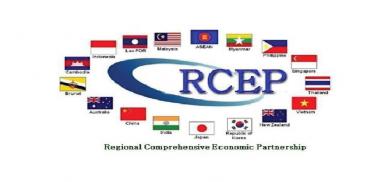How China dumped in India using the RCEP intra-trade route
China used both the ASEAN FTA and RCEP tariff concessions to enter the ASEAN market to make it a potential platform for sneaking into the Indian market through the ASEAN–India FTA.

With the debut of RCEP ( Regional Comprehensive Economic Partnership), China made a daunting entry into India, despite India withdrawing from the trade bloc. This demonstrates India’s failure to resist China’s foray into the market. China made backdoor entry into India through RCEP-ASEAN intra-trade and bilateral FTAs; ASEAN accounted for one-third of intra-RCEP trade. RCEP includes 15 countries – ASEAN 10 plus China, Japan, South Korea, Australia and New Zealand. It was ratified in January 2022.
India withdrew from RCEP fearing China’s predatory entry into India’s large market and damaging domestic manufacturing. China baffled India’s resilience using ASEAN through RCEP and India- ASEAN FTA. India’s substantial increase in imports from ASEAN with the launching of RCEP is a case in point.
During 2020-21 to 2022-23, India’s imports from ASEAN increased by 84.6 percent. Correspondingly, ASEAN imports from China increased by 43.9 percent between 2020 and 2022.
Much of India’s imports from ASEAN were due to large imports of electronic and electrical goods ( HS : 84 &85). Imports of these items increased by 39.8 percent during the two years- from US $ 12, 104.3 million in 2020-21 to 17,559.9 million in 2022-23.
Paradoxically, in the preceding two years, India’s imports of electrical and electronic goods from ASEAN declined. During 2018-19 to 2019-20, imports declined by 0.9 percent- from US$ 14,496.8 million in 2018-19 to US$ 14,365.9 million in 2019-20.
Dubious role
Parallel to this, ASEAN imports of similar electrical and electronic goods from China spurred during the same period. They increased by 34 percent from 2020 to 2022
The sudden rise in India’s imports from ASEAN vis-à-vis ASEAN imports from China shows a dubious role played by China in entering the Indian market. ASEAN is yet to develop its potential for the manufacture of critical components and parts for electrical and electronic goods, which India imports from ASEAN. China is the prime backbone. ASEAN manufacturers import from China, assemble them and export them to India and the world.
Thus, China has become the prime backbone for ASEAN for the supply chain of critical components and parts. China is the epicenter for semiconductor chip sales. Nearly 50 percent of global sales of chips is represented by China. Big foreign companies like SK Hynix, TSML, Samsung, UMC, Texas Instrument, and Micron Technology are manufacturing in China.
Suspicion arose over the advantages accrued to China, owing to trilateral trade agreements between ASEAN and China and ASEAN and India and RCEP. China had a bilateral FTA with ASEAN in 2009 and a multilateral FTA with ASEAN under RCEP in 2022. On the other hand, ASEAN had a bilateral FTA with India in 2010. These went in favour of China.
China used both the ASEAN FTA and RCEP tariff concessions to enter the ASEAN market to make it a potential platform for sneaking into the Indian market through the ASEAN–India FTA. No doubt, Rules of Origin (ROO) and Certificate of Origin( COO) were there for checks to avoid fraudulence. But flouting of rules could not be overruled due to lax customs clearance in these countries.
It is said that whenever the goods are traded between ASEAN and China under the ASEAN- China FTA, the COO is surreptitiously flouted owing to lax adherence to customs clearance practices in these countries

RCEP is the largest trade bloc. Intra-RCEP trade represented 50 percent of total RCEP trade with the world, or 13 percent of global trade in 2019. There is wide heterogeneity in trade within RCEP. China, Japan and South Korea accounted for 60 percent of intra-RCEP trade and Cambodia, Brunei and Laos accounted for 1 percent, according to the UNCTAD report.
ASEAN subservience
China is the biggest beneficiary of RCEP in terms of market accessibility in RCEP. In 2019, it held 29.8 percent of exports in intra-RCEP trade, according to UNCTAD.
ASEAN majors are on the brink of subservience to China’s trading hegemony. Most of the majors, viz, Thailand, Malaysia, Indonesia and Indonesia are facing a wide trade deficit with China after the ASEAN-China FTA in 2010. The trade deficit of ASEAN with China leapfrogged ten times between 2012 to 2021.
India withdrew from RCEP at the last moment, anticipating China’s dumping in Indian markets. Indian manufacturers argued that it would damage the Make in India initiative. They argued that hitherto most of the FTAs remained unsuccessful, given the fact that FTA members reaped more benefits than India. Given this, RCEP would be a big burden on domestic industry.
There are three challenges to counter China’s duping of RCEP. First, the PLI scheme (Production Linked Incentive) needs to be more incentivized to attract foreign investment in critical components and part manufacturers. The shift of Apple from the USA to India is a case in point. Apple vowed to make India the global hub for iPhone manufacturing. About one-third of Apple’s global iPhone production will be from India in the next 3-4 years, according to the New York Times.
Second, the global search for China alternatives for the supply chain. Third, enhancing free trade agreement routes to topple the burgeoning imports from China .
(The writer is an Indian trade consultant and analyst. Views are personal. He can be contacted at subratamajumder0604@gmail.com)
Youu realize a whole lot itts almost tough to argu with yyou (not
that I really would want to…HaHa). Yoou definitely pput a fresh
spin on a topic that has bewn written about for a long time.
Great stuff, just wonderful!










Post a Comment